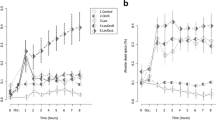Summary
Intravenous injection of gas (10–60 ml) causes acute pulmonary embolism, which disappears completely within 10–20 min. Intravenous infusion of gas (1–5 ml min−1) can be continued for a long time. During these infusions a steady state is reached in which pulmonary arterial pressure is increased and cardiac output remains unaltered. This indicates that the degree of embolization has reached a constant level despite the continuous gas infusion. These findings can be explained by a gradual disappearance of the bubbles from the pulmonary circulation. The purpose of this study was to measure the possible excretion of gas from the intravascular gas bubbles into the alveolar air after venous administration. Neon was used as a test gas since its fractional concentration in ambient air is low (0.00018) and it can be detected by gas chromatography with sufficient accuracy.
It could be demonstrated that after injection neon was present in the expiration gas. During the steady state of infusion the rate of excretion in the expiration gas appeared to be equal to the rate of infusion. Changes in the pulmonary arterial pressure curve were reflected in the neon wash-out curve. It may be concluded that during pulmonary gas embolism the administered gas is excreted into the alveolar air and that the excretion rate largely depends on the increased pulmonary arterial pressure due to the obstructing bubbles themselves.
Similar content being viewed by others
References
Boerema, B.: Vaatveranderingen na herhaalde gasemboli. Thesis, Amsterdam 1962
Byrne, J. J., Isales, R., Hickey, V. J.: Pulmonary vasoconstriction associated with minute pulmonary emboli. Surg. Forum4, 185–189 (1953)
Cate, W. R., Light, R. A., Daniel, R. A., Edwards, W. M.: Role of the autonomic nervous system in the control of the pulmonary vascular bed. I. Experimental pulmonary embolism. Surg. Forum4, 190–197 (1953)
Curtillet, E., and A.: Etude microscopique de l'embolie gazeuse. C. R. Soc. Biol.130, 647–650 (1939)
Daley, R., Wade, J. D., Maraist, F., Bing, R. J.: Pulmonary hypertension in dogs induced by injection of lycopodium spores into the pulmonary artery, with special reference to the absence of vasomotor reflexes. Am. J. Physiol.164, 380–390 (1951)
Deal, C. W., Fielden, B. P., Monk, I.: Hemodynamic effects of pulmonary air embolism. J. Surg. Res.11, 533–538 (1971)
Durant, T. M., Oppenheimer, M. J., Lynch, P. R., Asciano, G., Webber, D.: Body position in relation to venous air embolism. A roentgenologic study. Am. J. Med. Sci.227, 509–518 (1954)
Emerson, L. V., Hempleman, H. V., Lentle, R. G.: The passage of gaseous emboli through the pulmonary circulation. Respir. Physiol.3, 213–219 (1967)
Fouché, R. F., Fergusson, D. J. G., Beck, W.: Evidence for a slow vasomotor response following unilateral miliary embolization of pulmonary arteries in dogs. S. Afric. Med. J.40, 691–696 (1966)
Gilbert, J. W., Berglund, E., Dahlgren, S., Ovenfors, C. O., Barnes, R.: Experimental pulmonary hypertension in the dog. J. Thor. Cardiovasc. Surg.55, 565–571 (1968)
Harvey, E. N., Barnes, D. K., Mc Elroy, W. D., Whiteley, A. H., Pease, D. C., Cooper, K. W.: Bubble formation in animals. I. Physical factors. J. Cell. Comp. Physiol.24, 1–31 (1944)
Hayek, H. von: Kurz- und Nebenschlüsse des menschlichen Lungenkreislaufes in der Pleura. Z. Anat. Entwicklungsgeschichte112, 221–228 (1942)
Hayek, H. von: The Human Lung. New York: Hafner 1960
Knisely, W. H., Satterwhite, W. M., Wallace, J. M.: An attempt to demonstrate pulmonary arterio-venous anastomoses in rabbits, cats and dogs, and discussion of literature pertaining to such shunts. Circulation14, 960–961 (1956)
Knisely, W. H.: Normal morphology and some defined pathologic conditions of fine vessels of mammalian alveoli. In: The Microcirculation, chapter 13. A symposium. Eds. W. Winters and A. Brest. Springfield, Ill.: Thomas 1969
Lauwerijns, J.: De longvaten: hun architectoniek en hun rol bij de longontplooiing. Thesis, Brussel 1962
Mandelbaum, I., King, H.: Pulmonary air embolism. Surg. Forum14, 236–238 (1963)
Marchand, P., van Hasselt, H.: Massive venous air embolism. S. Afric. Med. J.38, 202–208 (1964)
Molenaar, A.: Post-traumatische vetembolie. Thesis, Nijmegen 1967
Niden, A. H., Aviado, D. M.: Effects of pulmonary embolism on the pulmonary circulation with special reference to arteriovenous shunts in the lung. Circ. Res.4, 67–73 (1956)
Prinzmetal, M., Ornitz, E. M., Simkin, B., Bergman, H. C.: Arterio-venous anastomoses in liver, spleen and lungs. Am. J. Physiol.152, 48–52 (1948)
Richardson, H. F., Coles, B. C., Hall, G. E.: Experimental gas embolism: intravenous air embolism. Can. Med. Assoc. J.36, 584–588 (1937)
Ring, G. C., Blum, A. S., Kurbatov, T., Moss, W. G., Smith, W.: Size of microspheres passing through the pulmonary circuit in the dog. Am. J. Physiol.200, 1191–1196 (1961)
Spencer, M. D., Oyama, Y.: Pulmonary capacity for dissipation of venous gas emboli. Aerospace Med.42, 822–827 (1971)
Steffey, E. P., Gauger, G. E., Eger, E. I.: Cardiovascular effects of venous air embolism during air and oxygen breathing. Anesth. Analg. (Cleve.)53, 599–604 (1974)
Szabo, G.: Die Fettembolie. Budapest: Akademiai Kiado 1971
Tobin, C. E.: Arterio-venous shunts in the peripheral pulmonary circulation in the human lung. Thorax21, 197–204 (1966)
Verstappen, F. T. J., Bernards, J. A., Kreuzer, F.: Effects of pulmonary gas embolism on circulation and respiration in the dog. I. Effects on circulation. Pflügers Arch368, 89–96 (1977a)
Verstappen, F. T. J., Bernards, J. A., Kreuzer, F.: Effects of pulmonary gas embolism on circulation and respiration in the dog. II. Effects on respiration. Pflügers Arch.368, 97–104 (1977b)
Weibel, E.: Die Blutgefäßanastomosen in der menschlichen Lunge. Z. Zellforsch. Mikroskop. Anat. Abt. Histochem.50, 653–692 (1959)
Wolffe, J. B., Robertson, H. F.: Experimental air embolism. Ann. Intern. Med.9, 162–165 (1935)
Wright, R. R.: Experimental pulmonary hypertension produced by recurrent air embolism. Med. Thorac.19, 423–427 (1962)
Author information
Authors and Affiliations
Rights and permissions
About this article
Cite this article
Verstappen, F.T.J., Bernards, J.A. & Kreuzer, F. Effects of pulmonary gas embolism on circulation and respiration in the dog. Pflugers Arch. 370, 67–70 (1977). https://doi.org/10.1007/BF00707947
Received:
Issue Date:
DOI: https://doi.org/10.1007/BF00707947




